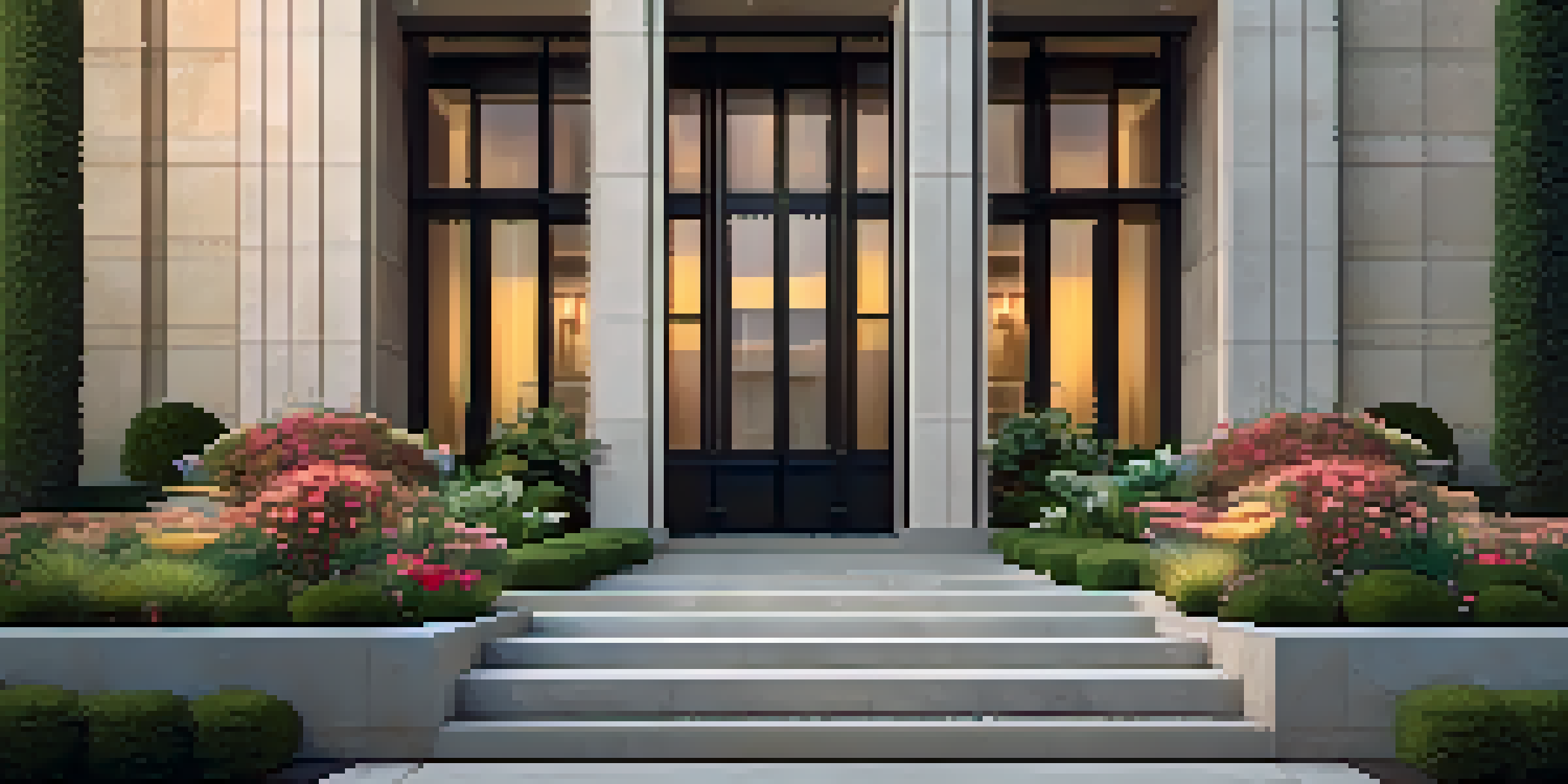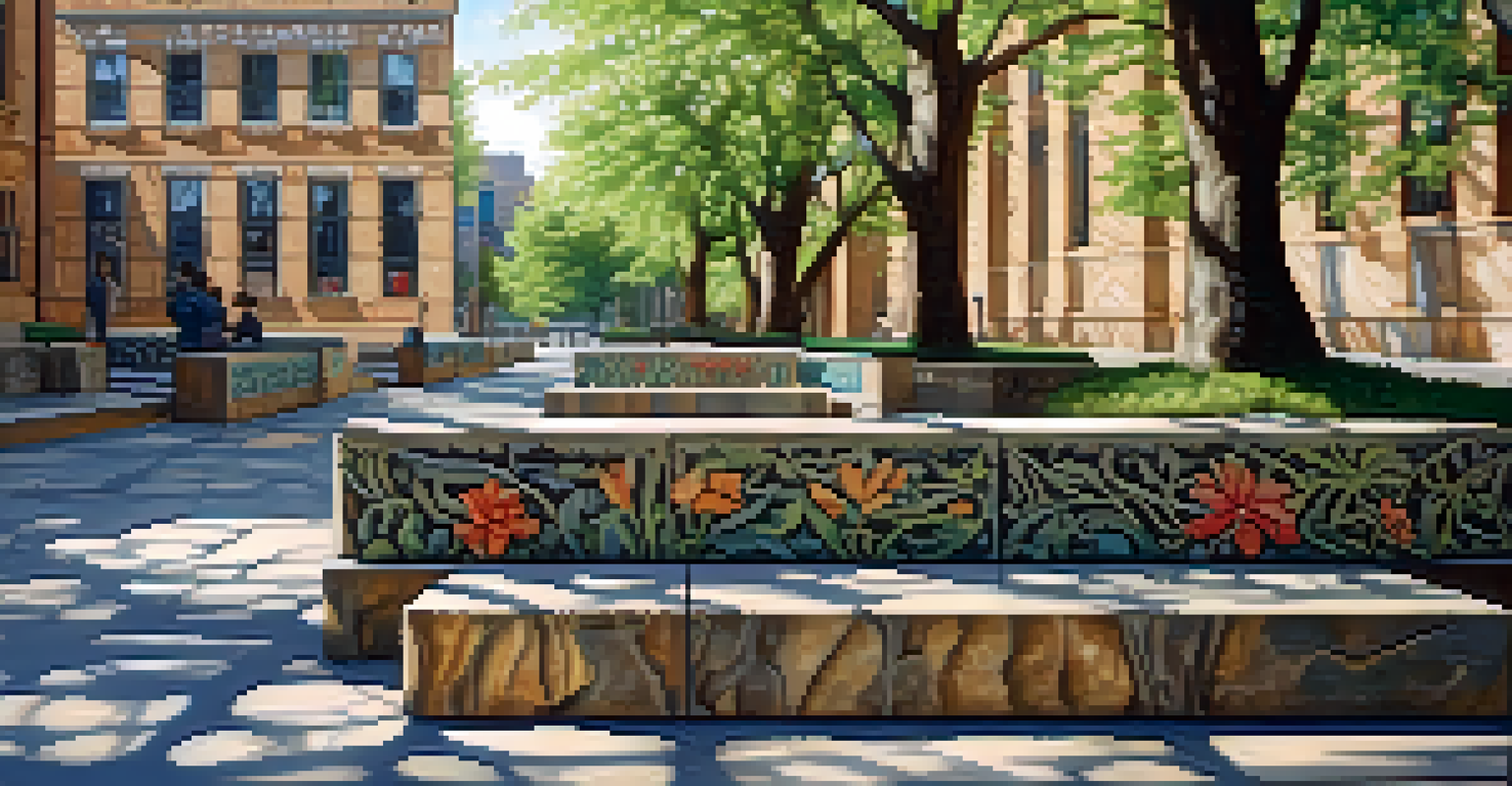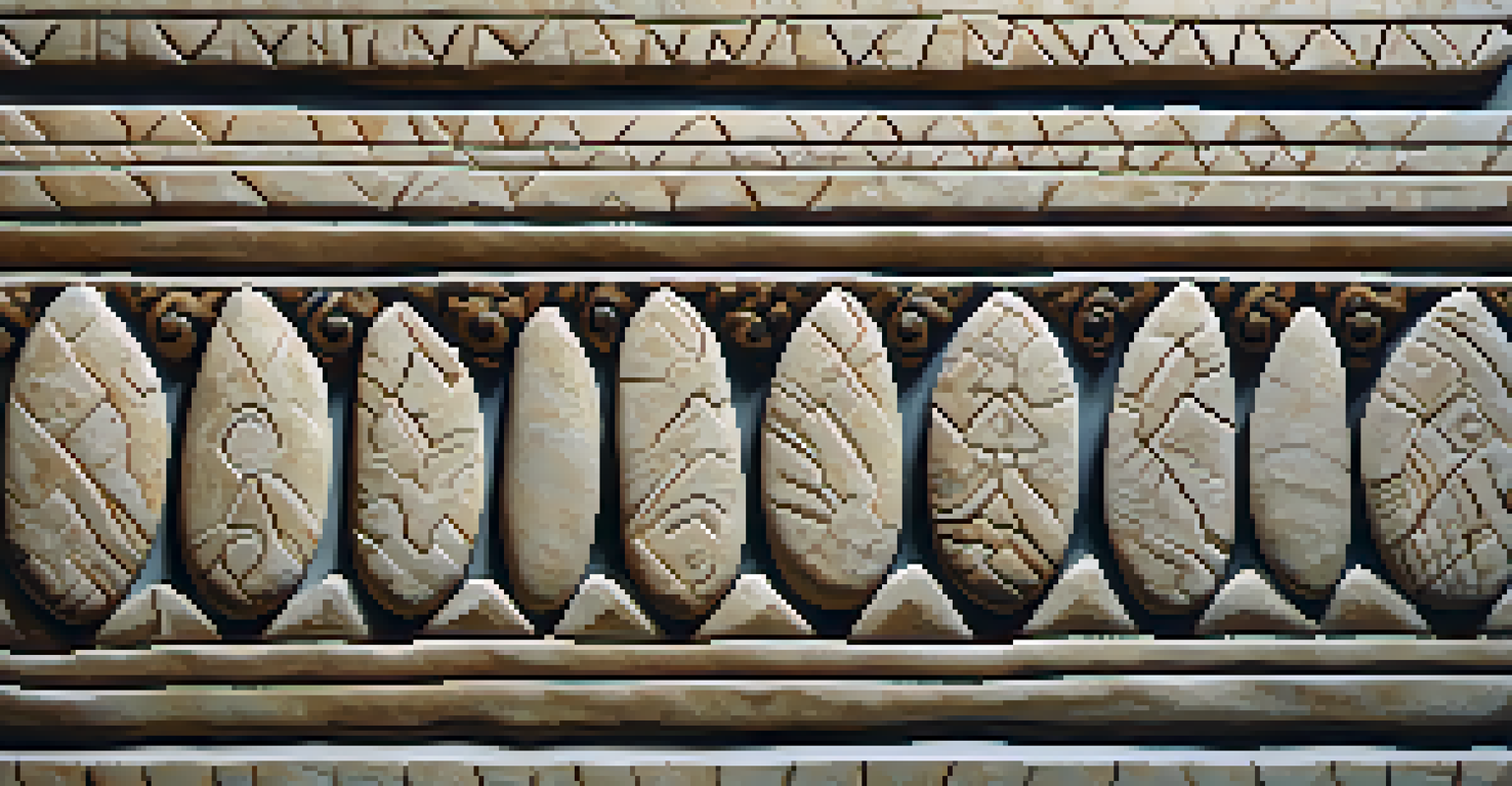Innovative Uses of Carved Stone in Modern Facade Design

The Timeless Appeal of Carved Stone in Architecture
Carved stone has been a hallmark of architecture for centuries, celebrated for its durability and aesthetic charm. Modern designers are increasingly incorporating this age-old material into contemporary facade designs, proving that it can harmonize with modern aesthetics. Its natural textures and colors provide a unique contrast to sleek materials like glass and steel, creating a visually striking balance.
Architecture is the thoughtful making of space.
Furthermore, the tactile quality of carved stone invites interaction, drawing people in with its warmth and character. Unlike cold, uniform materials, each piece of carved stone tells its own story, offering a sense of history and belonging. This blend of tradition and modernity not only enhances visual appeal but also enriches the overall experience of a building.
As architects and designers continue to experiment with this material, we're seeing a resurgence in the popularity of stone facades. This revival invites a new generation to appreciate the artistry of stone carving, ensuring that its legacy endures in contemporary architecture.
Sustainable Benefits of Carved Stone Materials
In an age where sustainability is paramount, carved stone presents an eco-friendly option for facade design. Natural stone has a low environmental impact, requiring minimal processing and energy to extract and shape. Additionally, its longevity means fewer replacements over time, which is a significant advantage in reducing waste.

Moreover, stone offers excellent insulation properties, helping to regulate a building's temperature naturally. This means less reliance on heating and cooling systems, which not only lowers energy consumption but also contributes to a building's overall sustainability profile. By choosing carved stone, architects can align their projects with green building practices.
Carved Stone Merges Tradition and Modernity
Modern architecture increasingly incorporates carved stone, blending its historical charm with contemporary design.
Ultimately, the use of carved stone is not only a nod to aesthetics but also a commitment to environmentally conscious construction. As more architects embrace sustainable materials, the appeal of carved stone will likely continue to grow.
Incorporating Cultural Elements through Stone Carving
Carved stone provides a unique canvas for expressing cultural narratives in architecture. By integrating local stone and traditional carving techniques, architects can pay homage to a region's heritage, adding layers of meaning to modern designs. This not only enhances the visual impact of a building but also fosters a sense of identity and belonging within the community.
The best way to predict the future is to create it.
For instance, a public library might feature motifs inspired by local folklore, inviting visitors to engage with the stories embedded in the stone. Such thoughtful integration transforms a simple facade into a storytelling medium, bridging the past and present. It’s a powerful reminder that architecture can be a reflection of cultural pride.
As communities increasingly seek to celebrate their unique identities, the role of carved stone in facade design becomes even more significant. By embracing local artistry, architects can create spaces that resonate with their surroundings, fostering connections among residents and visitors alike.
Innovative Patterns and Textures in Facade Design
One of the exciting aspects of using carved stone in modern facades is the ability to create intricate patterns and textures. Designers are pushing the boundaries of traditional stone carving, exploring geometric shapes, abstract designs, and even more organic forms. These innovations can transform a building’s exterior into a work of art, attracting attention and sparking curiosity.
For example, a building may feature a facade with wave-like carvings that mimic the surrounding landscape, seamlessly blending architecture with nature. This not only enhances the aesthetic appeal but also creates a dialogue between the building and its environment. Such creative uses of stone elevate the facade beyond mere functionality.
Sustainability Through Natural Materials
Carved stone is an eco-friendly choice, offering durability and excellent insulation while reducing environmental impact.
The versatility of carved stone allows architects to customize designs that cater to their vision while still respecting the material's inherent qualities. As technology advances, the possibilities for unique stone patterns and textures will undoubtedly expand, further revolutionizing facade design.
The Role of Technology in Stone Carving
Advancements in technology have transformed the way architects approach carved stone. With tools like CNC machines and 3D modeling software, the precision and complexity of stone carving have reached new heights. This not only allows for more intricate designs but also streamlines the production process, making it more accessible for modern projects.
For instance, architects can now create detailed prototypes and renderings of their designs, ensuring that the final product aligns with their vision. This technological integration minimizes waste and ensures a higher level of quality control in the carving process. It's a perfect marriage of artistry and engineering, enabling the exploration of bold new ideas.
As technology continues to evolve, it will likely open even more doors for creativity in stone design. The future of carved stone facades is bright, with limitless possibilities for innovation and expression.
Carved Stone in Urban Spaces: A Case Study
Cities around the world are beginning to incorporate carved stone into their urban landscapes, and one standout example is the recent redevelopment of a public square. The project features a series of carved stone benches and walls that serve as both functional elements and artistic installations. This integration of stone not only beautifies the space but also encourages social interaction among community members.
The choice of stone reflects the local geology, creating a sense of place and promoting environmental awareness. Each carved element tells a story, from patterns inspired by local flora to engravings that honor the region's history. The result is a vibrant public area that resonates with residents and visitors alike, fostering a sense of pride and belonging.
Cultural Narratives in Architecture
Integrating local stone and traditional carving techniques allows architects to celebrate regional heritage and foster community identity.
This case study exemplifies how carved stone can enhance urban environments, making them more inviting and engaging. As cities strive for sustainability and community connection, the role of stone in facade design will likely become increasingly important.
Challenges and Considerations in Using Carved Stone
While there are many benefits to using carved stone in facade design, there are also challenges to consider. One of the main issues is the weight of the material, which may require additional structural support in a building's design. This can complicate the construction process and increase costs, making it essential for architects to plan carefully.
Another consideration is the availability of suitable stone, as not all regions have access to high-quality carving materials. Architects must often work with local suppliers to ensure that the stone is not only aesthetically pleasing but also durable. Balancing design aspirations with practical limitations is a critical aspect of any project involving carved stone.

Despite these challenges, the rewards of incorporating carved stone into modern facades can far outweigh the difficulties. With careful planning and collaboration, architects can overcome these hurdles and create stunning, lasting designs that celebrate this remarkable material.
The Future of Carved Stone in Architectural Design
As we look to the future, the use of carved stone in architectural design promises to evolve alongside emerging trends in sustainability and artistry. With a growing emphasis on eco-friendly materials and local craftsmanship, carved stone is poised to regain its place as a favorite among architects and designers. This material can blend traditional techniques with modern aesthetics, creating a unique fusion that appeals to both old and new generations.
Additionally, as technology continues to advance, we can expect to see even more innovative applications of carved stone. From digitally designed patterns to smart building integrations, the possibilities are endless. Architects will likely explore new ways to harness the beauty and strength of stone while pushing the envelope on design.
Ultimately, the future of carved stone in architectural design is bright, filled with opportunities for creativity and sustainability. As we embrace this timeless material, we pave the way for a more harmonious relationship between our built environments and the natural world.